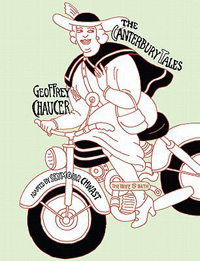 Seymour Chwast: The Canterbury Tales (Bloomsbury, 8/30/11)
Seymour Chwast: The Canterbury Tales (Bloomsbury, 8/30/11)
Even English nerds have trouble with The Canterbury Tales (and this coming from a self-proclaimed English nerd). Long, famously unfinished, written in archaic English, and littered with centuries-old humor, Chaucer’s classic is dense and difficult to understand. There is hope, however! Readers who struggled through Chaucer’s original will love Seymour Chwast’s witty and stylish take on the story. This new offering from the author of the Divine Comedy graphic novel revisits and revises the Middle English tome and makes it much more enjoyable.
The graphic-novel edition’s brevity gives it the edge over Chaucer, not to mention its translation into modern English. Pages of prose are reduced to captions and dry dialogue, while the action is streamlined and organized into neat panel formulations. “The Wife of Bath’s Prologue” is one of many short and to-the-point chapters in the story (“I met the first of my five husbands when I was twelve. They were mostly gentlemen. Didn’t God say to go forth and multiply?”).
Chwast condenses the narrative until he finds a sort of absurdist humor in minimalism — something that should be even funnier for fans of the original. However, first-time readers will be glad to know that even when the stories lose some of their impact (or sense) in translation, the essence of the story survives.
The novel’s innovative experimentation with layout and panels will delight design buffs and bookworms alike. Chwast’s penchant for diagrams breaks up the story and allows for some narrative shorthand (such as when the bedroom farce in “Reeve’s Tale” is shown through dotted lines and numbering on a drawing of the beds). He even includes the asides from other characters in the margins of stories, giving the whole endeavor the collaborative and co-written feel of the original stories.
The Canterbury Tales, in Chwast’s hands, is quirky and imaginative. His pilgrims ride motorcycles, argue and interrupt each other, and tell the most shocking stories while still maintaining a sense of fun and humor. The writing manages to get across a sense of character while avoiding description almost entirely. Instead, the characters introduce themselves, just as in Chaucer, but in as few words as possible. Grotesque metaphors are made literal through pen and ink; there’s murder and sex and bathroom humor within pages of each other (or in the same story). And yet the whole novel feels downright classy due to Chwast’s clean art and organized storytelling.
Chaucer’s humor and social critique were always the best part of the original, and they mostly survive the transition to graphic form. The essential story (a group of pilgrims travels to Canterbury and tells stories) gets an update, but not a rewrite.
This handsome hardcover forms a matched set with Chwast’s earlier Divine Comedy graphic novel, and it’s a worthy follow-up.

